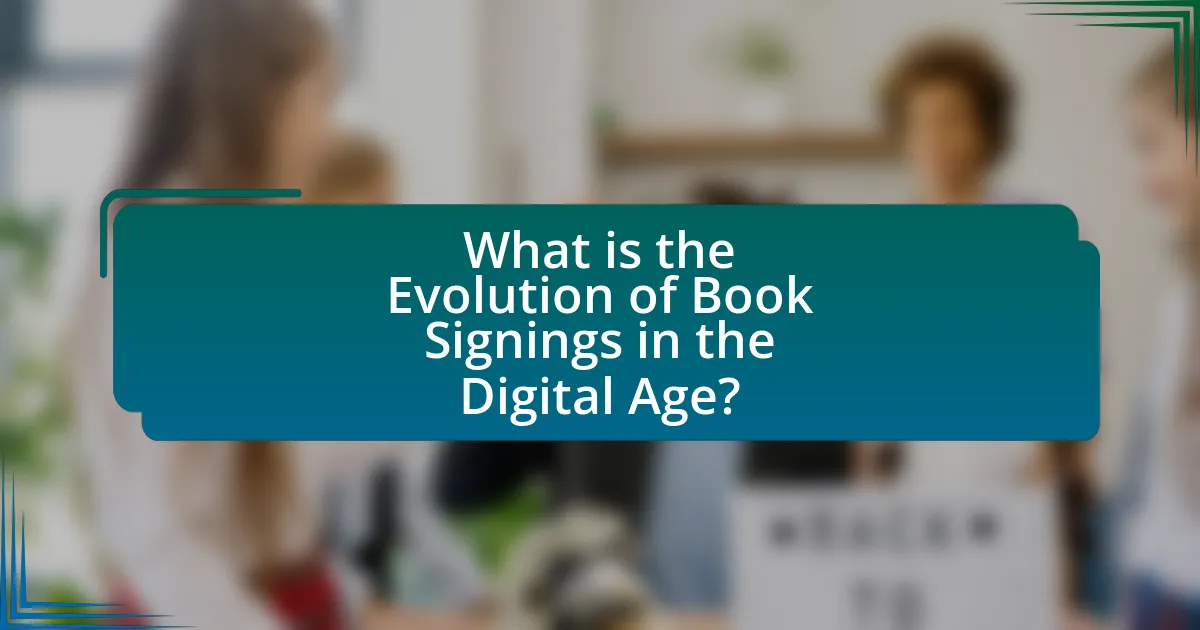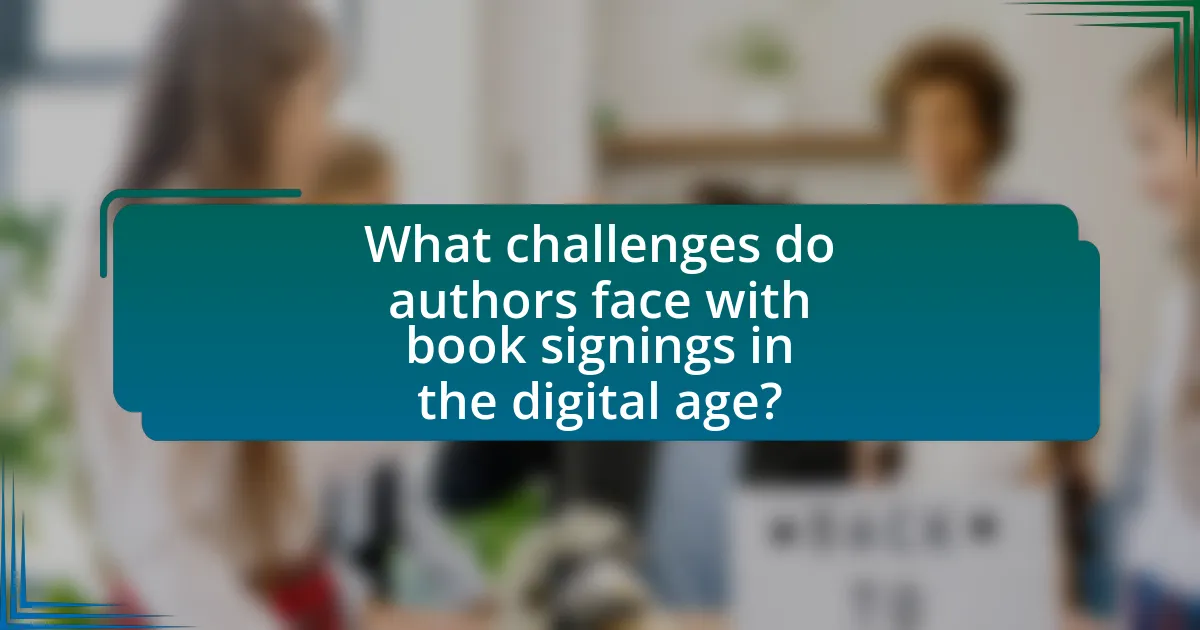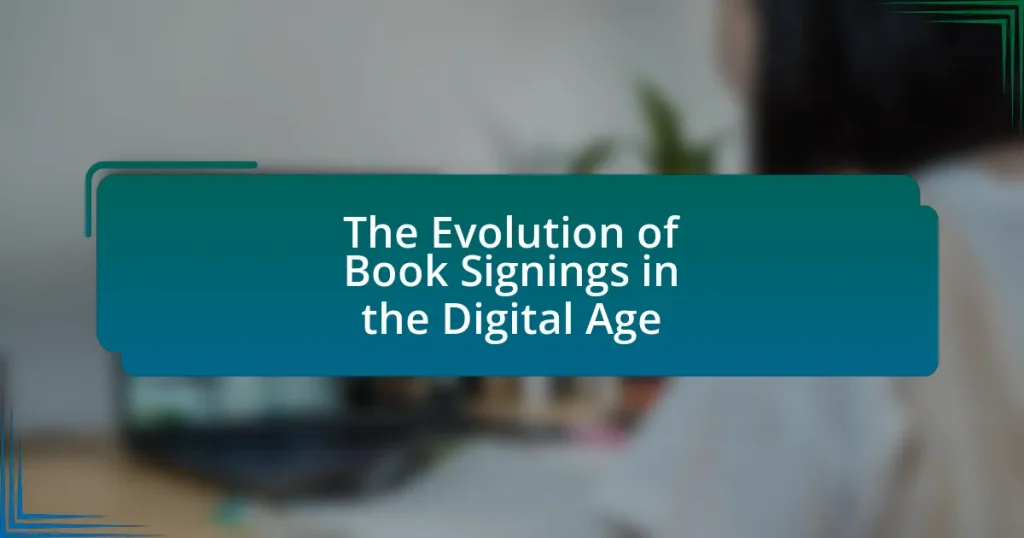The article examines the evolution of book signings in the digital age, highlighting the transition from traditional in-person events to virtual interactions facilitated by technology. It discusses how authors have adapted to digital platforms, particularly during the COVID-19 pandemic, to engage with a global audience through virtual signings and social media. Key characteristics of traditional signings are contrasted with modern practices, including the use of live streaming and online shopping, while also addressing the challenges and limitations authors face in this new landscape. The article concludes with best practices for authors to enhance reader engagement and maximize the effectiveness of both in-person and virtual signings.

What is the Evolution of Book Signings in the Digital Age?
The evolution of book signings in the digital age has transformed from traditional in-person events to virtual interactions facilitated by technology. Initially, book signings involved authors physically attending bookstores or events to meet fans and sign copies of their books. However, with the rise of social media and online platforms, authors now engage with readers through live-streamed events, virtual book tours, and social media interactions, allowing for broader reach and accessibility. For instance, during the COVID-19 pandemic, many authors adapted by hosting online signings, which resulted in increased participation from global audiences. This shift highlights the integration of digital tools in promoting literature and connecting authors with their readers, demonstrating a significant change in how book signings are conducted today.
How have traditional book signings changed over time?
Traditional book signings have evolved significantly from in-person events to include virtual formats. Initially, book signings were primarily held in bookstores or libraries, where authors interacted directly with fans, often resulting in long lines and limited accessibility. With the rise of digital technology, many authors now conduct virtual signings through platforms like Zoom or social media, allowing them to reach a global audience without geographical constraints. This shift has been accelerated by the COVID-19 pandemic, which prompted many events to move online. According to a 2021 survey by the American Booksellers Association, 70% of independent bookstores reported hosting virtual events, indicating a substantial change in how book signings are organized and attended.
What were the key characteristics of book signings before the digital age?
Book signings before the digital age were characterized by in-person events where authors interacted directly with readers, often held in bookstores or libraries. These events typically featured a limited number of books available for purchase, and attendees would queue to have their copies signed, creating a personal connection between the author and fans. Additionally, promotional efforts relied heavily on local advertising, word-of-mouth, and community engagement, as there were no online platforms to facilitate broader outreach. The atmosphere was often intimate, fostering a sense of exclusivity and excitement around the author’s presence, which was crucial for building a loyal readership.
How did technology begin to influence book signings?
Technology began to influence book signings through the introduction of online platforms and social media, which allowed authors to reach wider audiences and engage with fans remotely. The rise of e-commerce enabled virtual book signings, where readers could purchase signed copies online, eliminating geographical barriers. For instance, authors like Neil Gaiman and John Green have successfully utilized platforms like Instagram Live and Zoom to host virtual events, demonstrating the effectiveness of technology in expanding the reach and accessibility of book signings. This shift has transformed traditional in-person events into hybrid experiences, blending physical and digital interactions.
Why is the digital age significant for book signings?
The digital age is significant for book signings because it enhances accessibility and engagement for both authors and readers. Online platforms allow authors to reach a global audience, facilitating virtual book signings that can attract participants from various locations without the constraints of physical presence. For instance, during the COVID-19 pandemic, many authors successfully hosted virtual signings, demonstrating that digital tools can maintain reader interaction and sales. Additionally, social media enables authors to promote their events widely, increasing visibility and participation. This shift not only broadens the potential audience but also transforms the traditional book signing experience into a more interactive and inclusive event.
What role does social media play in modern book signings?
Social media plays a crucial role in modern book signings by enhancing visibility and engagement for authors and their events. Platforms like Instagram, Twitter, and Facebook allow authors to promote their signings to a broader audience, facilitating real-time interaction with fans. For instance, authors can share live updates, photos, and videos during the signing, creating a sense of community and excitement. According to a survey by the American Booksellers Association, 70% of authors reported that social media significantly increased attendance at their events, demonstrating its effectiveness in driving participation.
How has online shopping impacted the way authors connect with readers?
Online shopping has significantly transformed the way authors connect with readers by facilitating direct sales and enhancing engagement through digital platforms. Authors can now sell their books directly to consumers via online retailers, which allows for greater control over pricing and marketing strategies. This shift has led to increased opportunities for authors to interact with their audience through social media, virtual book tours, and online events, fostering a more personal connection. For instance, a survey by the Pew Research Center in 2021 indicated that 30% of adults reported purchasing books online, highlighting the growing trend of online book sales and the importance of digital engagement for authors.

What are the current trends in book signings today?
Current trends in book signings today include a significant shift towards virtual events, increased integration of social media for promotion, and a focus on personalized experiences for attendees. Virtual book signings have gained popularity due to their accessibility, allowing authors to reach a wider audience without geographical limitations. For instance, platforms like Zoom and Instagram Live enable authors to engage with fans in real-time, fostering a sense of community. Additionally, authors are leveraging social media to create buzz around their signings, often using hashtags and live interactions to enhance visibility. Personalized experiences, such as customized book inscriptions and interactive Q&A sessions, are also becoming common, as they cater to the desires of readers for a more intimate connection with authors. These trends reflect the evolving landscape of book signings, adapting to the preferences of modern readers and the realities of a digital-first world.
How are virtual book signings conducted?
Virtual book signings are conducted through online platforms that allow authors to interact with readers in real-time. Typically, authors use video conferencing tools such as Zoom or social media platforms like Facebook Live to host the event. During the signing, authors may read excerpts from their books, answer questions from attendees, and personalize digital copies of their books for fans. This format has gained popularity, especially during events like the COVID-19 pandemic, as it allows authors to reach a wider audience without geographical limitations.
What platforms are commonly used for virtual book signings?
Common platforms used for virtual book signings include Zoom, Facebook Live, and YouTube Live. These platforms facilitate real-time interaction between authors and readers, allowing for live Q&A sessions and personalized book signings. For instance, Zoom supports features like breakout rooms for smaller group interactions, while Facebook Live and YouTube Live enable authors to reach larger audiences simultaneously. The popularity of these platforms is evidenced by their widespread adoption during events like the COVID-19 pandemic, which accelerated the shift to virtual engagements in the literary community.
What are the benefits of hosting a virtual book signing for authors?
Hosting a virtual book signing offers authors increased accessibility to a broader audience, allowing them to connect with readers regardless of geographical limitations. This format eliminates travel costs and time constraints, enabling authors to engage with fans from various locations simultaneously. Additionally, virtual book signings can be recorded and shared, providing lasting content that can attract new readers over time. According to a survey by Book Riot, 70% of readers expressed interest in attending virtual events, highlighting the growing popularity and effectiveness of this approach in reaching diverse audiences.
What innovative strategies are authors using for book signings?
Authors are employing innovative strategies for book signings by integrating virtual events and interactive experiences. Virtual book signings allow authors to reach a global audience, utilizing platforms like Zoom or social media for live interactions, which can significantly increase participation compared to traditional in-person events. Additionally, authors are incorporating personalized video messages or signed bookplates sent to readers, enhancing the personal touch while accommodating remote fans. These strategies reflect a shift towards leveraging technology to create engaging and accessible signing experiences, as evidenced by the rise in online sales and attendance at virtual events during the pandemic.
How are authors leveraging live streaming for book signings?
Authors are leveraging live streaming for book signings by hosting virtual events that allow them to interact with fans in real-time, regardless of geographical barriers. This approach enables authors to reach a wider audience, as evidenced by the increase in participation during events like the 2020 virtual book tours, where authors reported attendance numbers that exceeded traditional in-person signings. Additionally, platforms such as Facebook Live, Instagram Live, and YouTube have facilitated these interactions, allowing authors to sign books live on camera and engage with viewers through Q&A sessions, thereby enhancing the reader experience and fostering community engagement.
What unique promotional tactics are being employed in the digital space?
Unique promotional tactics in the digital space include virtual book tours, social media live events, and interactive online experiences. Virtual book tours allow authors to reach a global audience through platforms like Zoom or Facebook Live, engaging readers directly and promoting their work effectively. Social media live events, such as Q&A sessions or readings, create real-time interaction, fostering a sense of community among fans. Interactive online experiences, including gamified content or augmented reality features, enhance reader engagement and create memorable promotional moments. These tactics leverage technology to expand reach and deepen connections with audiences, reflecting the evolving landscape of book promotion in the digital age.

What challenges do authors face with book signings in the digital age?
Authors face several challenges with book signings in the digital age, primarily due to the shift in consumer behavior and the rise of online platforms. Traditional in-person signings often struggle to attract attendees as readers increasingly prefer digital formats and online interactions. According to a 2021 survey by the Pew Research Center, 27% of Americans reported reading e-books, indicating a significant preference for digital content over physical books. Additionally, authors must compete with the convenience of online purchasing and the availability of virtual events, which can limit the foot traffic at physical signings. Furthermore, logistical issues such as venue costs, travel expenses, and scheduling conflicts can hinder authors’ ability to organize successful signings. These factors collectively contribute to the challenges authors face in engaging their audience through traditional book signings in a digitally dominated landscape.
What are the limitations of virtual book signings?
Virtual book signings have several limitations, primarily related to the lack of personal interaction and the challenges of technology. Unlike traditional signings, virtual events do not allow for face-to-face engagement, which can diminish the emotional connection between authors and readers. Additionally, technical issues such as poor internet connectivity or platform malfunctions can disrupt the experience, leading to frustration for both authors and attendees. Furthermore, virtual signings may limit the ability to personalize interactions, as authors often cannot physically sign books or engage in spontaneous conversations. These factors collectively hinder the overall experience compared to in-person events.
How do authors maintain engagement with readers during virtual events?
Authors maintain engagement with readers during virtual events by utilizing interactive elements such as live Q&A sessions, polls, and chat features. These strategies encourage real-time participation, allowing readers to ask questions and share their thoughts, which fosters a sense of community. For instance, a study by the Pew Research Center found that 73% of participants in virtual events appreciated the opportunity to interact directly with authors, highlighting the effectiveness of these engagement techniques. Additionally, authors often incorporate multimedia presentations or readings to enhance the experience, making it more dynamic and appealing to the audience.
What technical issues can arise during online book signings?
Technical issues that can arise during online book signings include connectivity problems, software glitches, and user interface challenges. Connectivity problems may lead to interruptions in the live stream, causing delays or disconnections that hinder the signing experience. Software glitches can result in features not functioning as intended, such as difficulties in accessing the signing platform or issues with video and audio quality. User interface challenges may confuse participants, making it hard for them to navigate the signing process or interact with the author effectively. These issues can detract from the overall experience and engagement of both the author and the audience.
How do authors navigate the balance between in-person and virtual signings?
Authors navigate the balance between in-person and virtual signings by strategically assessing audience reach, logistical considerations, and personal engagement preferences. In-person signings allow for direct interaction with fans, fostering a personal connection, while virtual signings expand accessibility to a broader audience, including those unable to attend physical events. According to a survey by the Author’s Guild, 70% of authors reported increased participation in virtual events during the pandemic, indicating a shift in how signings are approached. This dual approach enables authors to maximize their visibility and cater to diverse reader preferences, ultimately enhancing their promotional efforts.
What factors influence an author’s decision to choose one format over the other?
An author’s decision to choose one format over another is influenced by audience reach, cost-effectiveness, and personal comfort with technology. For instance, digital formats allow authors to connect with a global audience instantly, while traditional formats may offer a more personal interaction. Cost considerations also play a significant role; digital events often incur lower expenses compared to physical signings, which require venue rentals and travel. Additionally, an author’s familiarity with digital tools can affect their choice; those comfortable with technology may prefer virtual signings, while others may opt for in-person events to maintain traditional engagement methods.
How can authors effectively combine both formats for maximum reach?
Authors can effectively combine in-person and virtual formats for maximum reach by leveraging social media platforms and live streaming technologies. By promoting in-person events through social media, authors can attract a larger audience, while simultaneously offering virtual participation options to engage those unable to attend physically. For instance, a study by the Pew Research Center indicates that 72% of adults use social media, providing a vast potential audience for promotional efforts. Additionally, using platforms like Zoom or Facebook Live allows authors to interact with fans in real-time, enhancing engagement and broadening their reach beyond geographical limitations. This dual approach not only increases visibility but also fosters a sense of community among readers, ultimately leading to higher book sales and a more robust author brand.
What best practices should authors follow for successful book signings in the digital age?
Authors should leverage social media and online platforms to promote their book signings effectively. By utilizing platforms like Facebook, Instagram, and Twitter, authors can create event pages, share updates, and engage with potential attendees, which increases visibility and attendance. Research indicates that 70% of consumers are influenced by social media when making purchasing decisions, highlighting its importance in driving interest in events. Additionally, authors should consider partnering with local bookstores or libraries to host signings, as these venues often have established customer bases and can provide logistical support. Engaging with fans through live streaming or virtual signings can also expand reach, allowing authors to connect with audiences who may not be able to attend in person.
How can authors promote their book signings effectively?
Authors can promote their book signings effectively by leveraging social media platforms to reach a wider audience. Utilizing platforms like Facebook, Instagram, and Twitter allows authors to create event pages, share engaging content, and interact with potential attendees. Research indicates that 73% of marketers believe that their efforts through social media marketing have been “somewhat effective” or “very effective” for their business (Buffer, 2021). Additionally, authors should collaborate with local bookstores or libraries to host events, as these venues often have established customer bases and can help with promotion. Email newsletters can also be an effective tool, as studies show that email marketing has an average ROI of $42 for every dollar spent (Litmus, 2021). By combining these strategies, authors can maximize visibility and attendance at their book signings.
What tips can authors use to enhance the reader experience during signings?
Authors can enhance the reader experience during signings by engaging directly with attendees, personalizing interactions, and creating a welcoming atmosphere. Engaging directly involves asking readers about their favorite parts of the book or their reading preferences, which fosters a connection. Personalizing interactions can include writing customized messages in each book, making readers feel valued. Creating a welcoming atmosphere can be achieved by setting up comfortable seating, providing refreshments, and playing background music, which encourages a relaxed environment. These strategies have been shown to increase reader satisfaction and create memorable experiences, as evidenced by positive feedback from attendees at author events.


